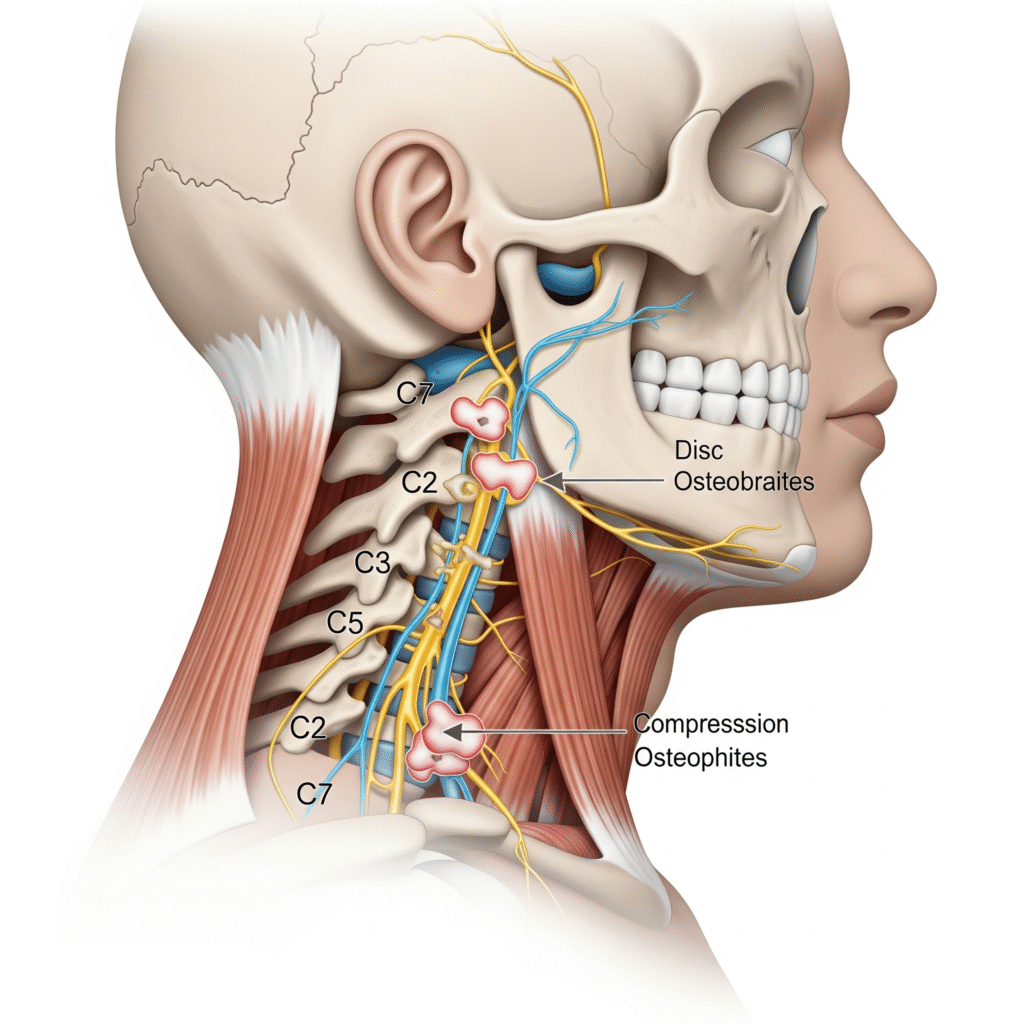Cervical Spondylosiss
Introduction
Cervical spondylosis is a degenerative condition that affects the spine (neck area) of the cervix, which is caused by intervertebral discs, joints, and ligaments, and tears of ligaments. It is common with aging and can cause neck pain, stiffness, nervous compression, and, in severe cases, causing spinal partnership. Risk factors include poor posture, repetitive neck tension, injury and genetic tendency.

Types of Cervical spondylosis
Cervical Radiculopathy
It occurs when a nerve root in the cervical spine is compressed or irritated, causing pain, numbness, tingling, or weakness in the shoulders, hands, or hand radiation.
Cervical Myelopathy
Happens when the spinal cord is compressed due to degenerative changes. Symptoms include difficulty walking, loss of hand coordination, muscle weakness, and bladder or bowel disturbances.
Axial Neck Pain Type
The characteristic of pain and stiffness is localized in the area of the neck without significant nerve or spinal partnership. Pain may deteriorate with prolonged, bad posture or neck speed.
Cervical headache type
Neck problems trigger symptoms of headache, usually felt behind the head and sometimes radiated in the forehead or temples. This cervical spine is due to nerve irritation.
Causes of Cervical spondylosis
- Age-related degeneration of intervertebral discs and cervical vertebrae.
- Prolonged posture, especially during desk or computer work.
- Repeated neck movements lead to chronic strain.
- Back neck injuries or trauma.
- Genetic tendency to the initial spinal cord degeneration.
- Weak lifestyle leads to weak neck muscles.
- Business related to heavy lifting or overhead work.
- The formation of osteophyte (bone spur) irritates the veins.
- Disc dehydration and loss of cushioning.
- Weaken the spinal cord ligaments over time.
- Chronic smoking reduces spinal disc nutrition.
- Spinal load is increasing in additional body weight.
Clinical features of Cervical spondylosis:
Neck pain and hardness
Constant or stalled pain in the neck, often movement or worse with long -term posture, with low neck flexibility.
Arms pain
Nerve root compression (cervical radiculopathy) causes pain due to spreading from the neck to shoulders, arms or hands.
Numbness and tingling
The loss of sensation in the upper limbs or the feeling of “pin-and-sui” reflects nerve partnership.
muscle weakness
Weapons or hands weakness due to nerve compression or spinal participation.
Headache
The cervical headache begins in the neck and radiation at the back or front of the head.
Symptoms associated with Cervical spondylosis:
- Constant neck pain, often deteriorates with activity.
- Hardness in the neck, especially after rest or morning.
- There is pain in the shoulders, weapons, or hands.
- Numbness or tingling sensations in the upper limbs.
- Weapon or weakness in the strength of catch.
- Headache arising from the neck area.
- Difficulty in turning or bending the neck.
- Topical dizziness or balance problem.
Investigations in Cervical spondylosis:
- The bone spurs, disc space reveals degenerative changes such as narrowing and vertebral alignment issues, helping to confirm the diagnosis and assess the severity of cervical spondylosis.
The disc provides wide images of the spinal cord, and veins, not visible on the X-ray to detect herniated discs, nerve compression, or spinal damage.
Micro-fracture provides cross-sectional bone imaging to detect the narrowness of spinal canal in bone spurs, or cervical spondylosis.
Assessment of renal osteodystrophy
Cervical spondylosis evaluates the speed and strength of nerve signal transmission, helping to identify nerve damage or compression.
The spinal canal uses a contrast dye with X-rays or CT to imagine the areas of compression in nerve roots and cervical spondylosis.
Czech for osteoporosis, which can spoil the spinal cord degeneration and increase the risk of fracture in cervical spondylosis patients.
Mimiting infections or inflammatory conditions mimic the spondylosis of the cervix, such as rheumatism or ankyloging spondylitis.
